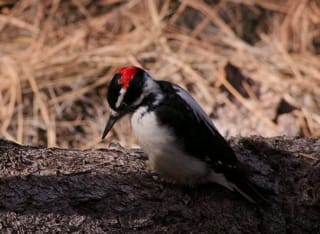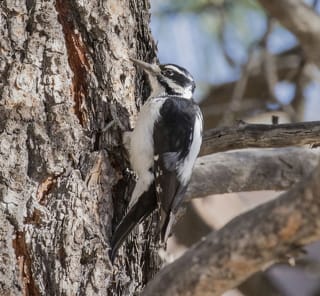Initially this guide displays common birds of all types that are flying right now in our area. Use the selectors below to view rare birds, view birds flying any time, restrict the output to a certain shape of bird, or search by name.
New Mexico is on the western edge of the Central Flyway which is one of the major migration pathways between north and south for birds traveling between breeding and wintering grounds along the Rocky Mountains. This has resulted in the state having an incredible diversity of birds with over 550 different species reported. A little more than half of this number are sighted annually on the Pajarito Plateau. Some of these birds are full-time residents, some migrate here for a few weeks or months, and other are only seen briefly as they pass through the region.
This guide features many of the birds known to frequent Los Alamos county by when they are likely to be seen in the area. You can get additional information on local birds by joining PEEC Birders or going to the eBird website. eBird also includes lists of rare bird sightings and birding hot spots.
Bird References
Birdweb
Cornell Lab of Ornithology
eBird
eNature
Institute for Bird Populations
National Audubon Society
New Mexico Ornithology Society
What Bird
xeno-canto
Subject Area Experts (all guides)
Steve Cary (butterflies)
Beth Cortright (insects)
Terry Foxx (invasive plants)
Leslie Hansen (mammals)
Richard Hansen (fish, mammals)
Dorothy Hoard (butterflies, trees)
Chick Keller (flowers, herbarium)
Shari Kelley (geology)
Kirt Kempter (geology)
Garth Tietjen (reptiles)
David Yeamans (birds)
Web Development and Content Management
Pat Bacha
Jennifer Macke
Graham Mark
Akkana Peck
Contact
Please contact us for local nature questions and sightings. We welcome comments, corrections, and additions to our guides.
For more information about local nature, please visit our Nature Blog or subscribe to PEEC This Week.
Make Selection
 Photo: male by Bob Walker  Photo: male by Mitch Chapman  Photo: female by Mouser Williams |  Hairy WoodpeckerHAWO (Picoides villosus, Dendrocopos villosus)Family: Picidae (Woodpeckers) Size: 9 in (23 cm) Flies: Jan 01 - Dec 31 Morphology: both sexes have black upper parts with white spots on the wings, black head with prominent whit stripes, long beak, white belly, a white patch down the center of the back, and pure white tail feathers; males have a red patch on the back of the head Status: native; common Food source: mostly insects but will eat some seeds and berries; will also feed on sap from damaged trees Habitat: deciduous forest The Hairy Woodpecker appears to be a larger version of the Downy Woodpecker. However, the two species are not closely related and do not compete for food. Like other woodpeckers, they have a spongy pad between their bill and skull to protect their brains from the shock of tapping on trees and special feathers around their nostrils to keep out wood chips. A Hairy Woodpecker will tap at a tree truck or major branch, listening for sound differences indicating an insect tunnel. It will then dig away the wood and remove the insect with its long, barbed tongue. These birds are very beneficial, consuming large numbers of wood-boring insects including those in wooden house siding. Hairy Woodpeckers are rather shy but will come to suet feeders. Males and females tend to maintain separate territories but pair up in mid-winter, often with the mate from the previous year. Nests consist of an cavity in an aspen or dead conifer. Info Photos Distribution Frequency |
